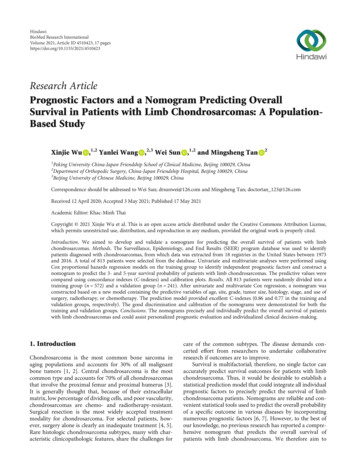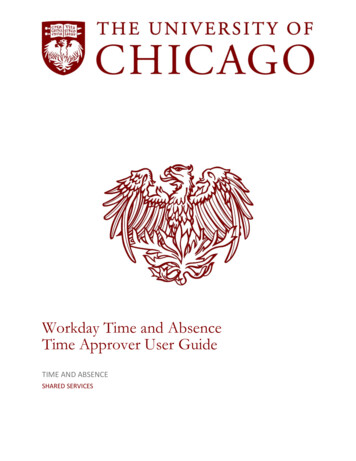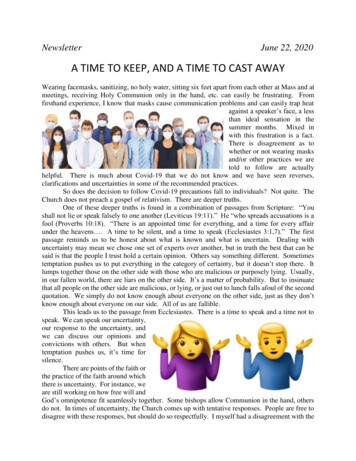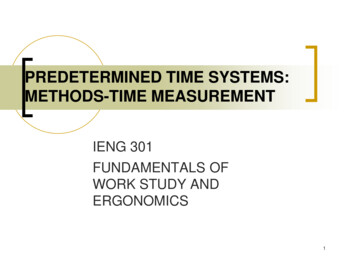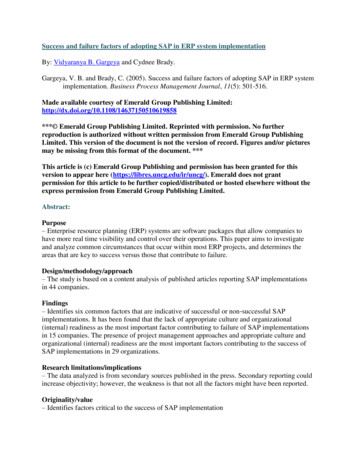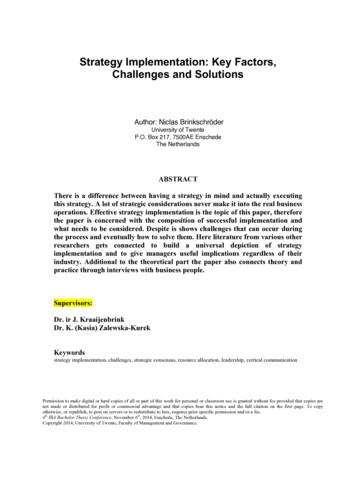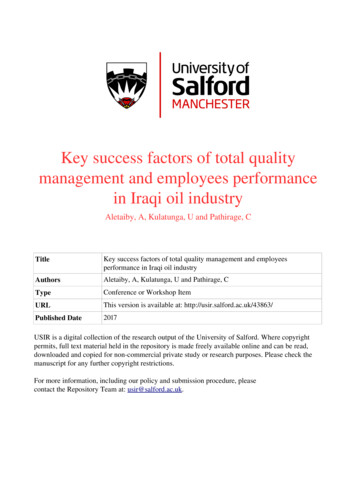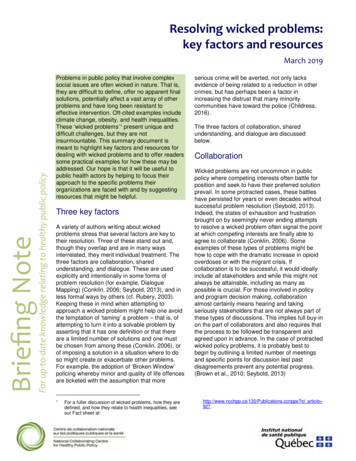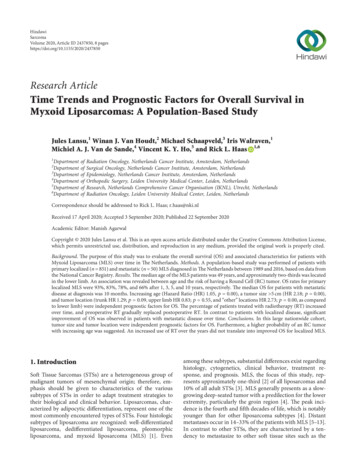
Transcription
HindawiSarcomaVolume 2020, Article ID 2437850, 8 pageshttps://doi.org/10.1155/2020/2437850Research ArticleTime Trends and Prognostic Factors for Overall Survival inMyxoid Liposarcomas: A Population-Based StudyJules Lansu,1 Winan J. Van Houdt,2 Michael Schaapveld,3 Iris Walraven,1Michiel A. J. Van de Sande,4 Vincent K. Y. Ho,5 and Rick L. Haas artment6Department2ofofofofofofRadiation Oncology, Netherlands Cancer Institute, Amsterdam, NetherlandsSurgical Oncology, Netherlands Cancer Institute, Amsterdam, NetherlandsEpidemiology, Netherlands Cancer Institute, Amsterdam, NetherlandsOrthopedic Surgery, Leiden University Medical Center, Leiden, NetherlandsResearch, Netherlands Comprehensive Cancer Organisation (IKNL), Utrecht, NetherlandsRadiation Oncology, Leiden University Medical Center, Leiden, NetherlandsCorrespondence should be addressed to Rick L. Haas; r.haas@nki.nlReceived 17 April 2020; Accepted 3 September 2020; Published 22 September 2020Academic Editor: Manish AgarwalCopyright 2020 Jules Lansu et al. This is an open access article distributed under the Creative Commons Attribution License,which permits unrestricted use, distribution, and reproduction in any medium, provided the original work is properly cited.Background. The purpose of this study was to evaluate the overall survival (OS) and associated characteristics for patients withMyxoid Liposarcoma (MLS) over time in The Netherlands. Methods. A population-based study was performed of patients withprimary localized (n 851) and metastatic (n 50) MLS diagnosed in The Netherlands between 1989 and 2016, based on data fromthe National Cancer Registry. Results. The median age of the MLS patients was 49 years, and approximately two-thirds was locatedin the lower limb. An association was revealed between age and the risk of having a Round Cell (RC) tumor. OS rates for primarylocalized MLS were 93%, 83%, 78%, and 66% after 1, 3, 5, and 10 years, respectively. The median OS for patients with metastaticdisease at diagnosis was 10 months. Increasing age (Hazard Ratio (HR) 1.05, p 0.00), a tumor size 5 cm (HR 2.18; p 0.00),and tumor location (trunk HR 1.29; p 0.09, upper limb HR 0.83; p 0.55, and “other” locations HR 2.73; p 0.00, as comparedto lower limb) were independent prognostic factors for OS. The percentage of patients treated with radiotherapy (RT) increasedover time, and preoperative RT gradually replaced postoperative RT. In contrast to patients with localized disease, significantimprovement of OS was observed in patients with metastatic disease over time. Conclusions. In this large nationwide cohort,tumor size and tumor location were independent prognostic factors for OS. Furthermore, a higher probability of an RC tumorwith increasing age was suggested. An increased use of RT over the years did not translate into improved OS for localized MLS.1. IntroductionSoft Tissue Sarcomas (STSs) are a heterogeneous group ofmalignant tumors of mesenchymal origin; therefore, emphasis should be given to characteristics of the varioussubtypes of STSs in order to adapt treatment strategies totheir biological and clinical behavior. Liposarcomas, characterized by adipocytic differentiation, represent one of themost commonly encountered types of STSs. Four histologicsubtypes of liposarcoma are recognized: well-differentiatedliposarcoma, dedifferentiated liposarcoma, pleomorphicliposarcoma, and myxoid liposarcoma (MLS) [1]. Evenamong these subtypes, substantial differences exist regardinghistology, cytogenetics, clinical behavior, treatment response, and prognosis. MLS, the focus of this study, represents approximately one-third [2] of all liposarcomas and10% of all adult STSs [3]. MLS generally presents as a slowgrowing deep-seated tumor with a predilection for the lowerextremity, particularly the groin region [4]. The peak incidence is the fourth and fifth decades of life, which is notablyyounger than for other liposarcoma subtypes [4]. Distantmetastases occur in 14–33% of the patients with MLS [5–13].In contrast to other STSs, they are characterized by a tendency to metastasize to other soft tissue sites such as the
2extremities, trunk, retroperitoneum, pleura, pericardium,and even to the bone [2, 14–16]. MLS is relatively sensitive toradiotherapy (RT) [12, 17, 18] and chemotherapy [19, 20], incomparison to other STSs. Local control is achieved in60–98% of patients [4, 7, 8, 11–14, 18, 21–23], resulting infavorable 5-year overall survival (OS) rates of 67–90%[5, 9, 11–13, 21, 23–25].Although sample sizes in most of theprevious studies are small due to the rarity of the disease,several prognostic factors in MLS have been identified. Ageat diagnosis 45years, tumor size 10 cm, presence of 5%round cell component, and positive resection margins areassociated with worse (disease-specific) survival[5, 7, 8, 11, 13, 21, 23–25]. To overcome these small samplesizes and generate sufficient statistical power, nationalcancer registries have great potential to come to more definitive conclusions based on unselected observations[24].The purpose of this study was to characterize demographics, with the round cell component in particular (I), OSrates (II) and prognostic factors (III) for MLS in a nationwide retrospective cohort of 901 patients treated between 1989 and 2016 in The Netherlands. Furthermore, timetrends of treatment and OS of MLS were studied (IV).2. Patients and Methods2.1. Data Collection. The data were derived from The Netherlands Cancer Registry (NCR). The NCR used the DutchPathology Network (PALGA), supplemented with a linkagewith the National Registry of Hospital Discharge Diagnosis toidentify patients with histologically diagnosed MLS in TheNetherlands between 1989 and 2016. Demographics, tumorcharacteristics, and treatment information were obtained fromhospital records by trained NCR registry administrators. Thedate of death was extracted from the Municipal PersonalRecords Database. Tumor size was extracted from the T-stagein the pathological report, and if not applicable or in case ofneoadjuvant treatment, the clinical T-stage was used. Reportedprimary tumor locations were classified to the upper limb,lower limb, trunk, or “other locations”. Other locations included the head and neck, peritoneum, retroperitoneum,mediastinum, and both male and female genital organs. Disease was considered to be primary localized in case of lackinginformation regarding the metastatic spread, given the very lowproportion of cases with primary metastatic disease versusprimary localized disease [24] and assuming that a detecteddistant metastasis at diagnosis is very unlikely not to be reported. A high-grade tumor, from here, termed Round Cell(RC) tumor, was defined as a tumor containing 5% of RoundCell Component (RCC) [6, 7]. RCC was assessed as a prognostic factor for OS, dichotomized to 5% or 5% RCC. Fromall 903 identified histologically confirmed MLS patients in theNCR database, two patients were excluded because of emigration-related lost to follow-up, and a total of 901 patientswere included within this study.2.2. Statistical Analysis. Baseline characteristics are presented as percentage, mean ( standard deviation), or median ( interquartile range (IQR)) in case of a skewedSarcomadistribution. Differences in baseline characteristics and inpatients with localized versus metastatic disease and MLSsversus RC tumors were tested using Student’s t-tests(continuous variables) and Chi-square tests (categoricalvariables). The follow-up duration for all patients was calculated as the time between the date of diagnosis and date ofdeath or date of most recent linkage with The NetherlandsPopulation Registry at January 31st 2017. Follow-up forpatients alive was estimated using the reverse Kaplan–Meierapproach. Patients with primary metastatic disease wereanalysed separately. OS was analysed by the Kaplan–Meiermethod, and subgroups were compared by Log-Rank tests.To investigate prognostic factors for OS, aiming to supportdoctors in informing their patients about their prognosis inthe consultation room, cox proportional hazard analyseswere performed. A multivariable model was constructedusing a backward selection procedure, including variableswith p values 0.10 [26]. Treatment-related factors wereexcluded from the model to prevent indication-to-treat bias.A Hazard Ratio (HR) is always presented with a 95%Confidence Interval (CI).Sensitivity analyses were performed to investigate the independent association of RCtumors. For this, we first constructed a univariate model.Then, one potential explanatory variable was added, and thepercentual change ( %) of the HR of the RC tumor variablewas calculated by performing an association cox regressionmodel. The localized disease cohort was split into fourgroups based on their year of diagnosis (quartiles), in orderto analyse time trends by mutually comparing those quartiles. Given the relatively small number of primary metastatic cases and, moreover, characterized by a heterogeneityof sites and number of metastases, the metastatic cohort wassplit into two subgroups (before and after the median year ofdiagnosis) for time trend analysis, and no prognostic factoranalysis was performed. All tests were two-sided, andp 0.05 was considered as statistically significant. Statisticalanalysis of the data was performed by using IBM SPSSStatistics V25.3. Results3.1. Demographics. In the study population, which consistedof 512 (57%) males and 389 (43%) females, the median age atdiagnosis was 49 years (IQR 38–62 years). Evidence ofdistant metastasis at diagnosis was present in 50 (6%) patients. An overview of baseline characteristics is presented inTable 1. In this study population, 77 (9%) of tumors were RCtumors. Patients with RC tumors were significantly older ascompared to patients with MLS (median age 53 vs. 48 years,respectively; p 0.01) (Supplementary Materials Table 1).The distribution of the probability of having a RC tumor bythe age group is shown in Figure 1.3.2. Overall Survival (OS). The median follow-up for allpatients was 7.6 years (IQR 2.4–15.3 years), 8.3 years (IQR2.8–15.8 years) for patients with localized and 0.8 years (IQR0.5–1.9 years) for patients with metastatic disease at diagnosis. Median follow-up for patients alive at time of the last
Sarcoma3Table 1: Baseline characteristics of patients with localized and metastatic disease at diagnosis.CharacteristicsTotal patients (n )Median follow-up (years)(IQR)GenderMaleFemaleTumor locationUpper limbLower limbTrunkOtherTumor gradeIntermediate grade (MLS)High grade (RC tumor)Age (years) 4040–5556–70 70TNM cal resectionRadical (R0)Microscopic irradical(R1)Macroscopic irradical (R2)Unknown status (Rx)No surgeryOther treatmentsRadiotherapy (RT)ChemotherapyLocalized disease8518.3 [2.8–15.8]Metastatic disease500.8 [0.5–1.9]Total9017.6 [2.4–15.3]480 (56%)371 (44%)32 (64%)18 (36%)512 (57%)389 (43%)5155117079(6%)(65%)(20%)(9%)2 (4%)26 (52%)15 (30%)7 (14%)5357718586779 (92%)72 (8%)45 (90%)5 (10%)824 (91%)77 (9%)238 (28%)304 (36%)204 (25%)105 (12%)8 (16%)16 (32%)16 (32%)10 (20%)352 (39%)312 (35%)169 (19%)68 (7%)12 (1%)173 (20%)502 (59%)164 (19%)569 (67%)2 (0%)280 (33%)648 (76%)0203 (24%)1 (2%)018 (36%)31 (62%)21 (42%)5 (10%)24 (48%)050 (100%)013 (1%)173 (19%)520 (58%)195 (22%)590 (66%)7 (1%)304 (34%)648 (72%)50 (6%)203 (23%)368571536645(43%)(7%)(2%)(43%)(5%)4 (8%)2 (4%)7 (14%)8 (15%)29 (58%)372592237474452 (53%)50 (6%)14 (28%)19 (38%)466 (52%)69 (8%)p .000(41%)(7%)(2%)(42%)(8%)0.000The P value represents outcome of Chi-square statistical testing (or the Student’s t-test in case of an continuous variable). Abbreviations: pT pathological Tstage, cN clinical nodal stage, cM clinical metastasis stage, N.S. not significant.follow-up was 13.9 years for localized and 5.9 years formetastatic disease. For all patients with localized disease, the1-, 3-, 5-, and 10- year OS rates were 93%, 83%, 78%, and66%, respectively. The OS rates for localized disease, stratified for age, tumor size, RCC, and tumor location areprovided in Supplementary Materials Table 2. For patientswith metastatic disease at diagnosis, OS rates were significantly lower as compared to localized disease (HR 8.71; 95%CI 6.18–12.28; p 0.00). OS rates for metastatic disease after1, 2, and 3 years were 47%, 29%, and 24%, respectively.3.3. Prognostic Factors in Localized Disease. Increasing age(HR 1.05; 95% CI 1.05–1.06; p 0.00), a tumor size 5 cm(HR 2.42; 95% CI 1.73–3.37; p 0.00), RC tumor (HR 1.66;95% CI 1.20–2.31; p 0.00), male gender (HR 1.25; 95%1.00–1.56; p 0.04), and tumor location (trunk HR 1.74;95% CI 1.34–2.26; p 0.00, upper limb HR 0.79; 95% CI0.47–1.34; p 0.38, and other HR 3.78; 95% CI 2.82–5.06;p 0.00) with the lower limb as the reference location werefound to be significant prognostic factors for OS in univariate analysis. Of note, the lower limb was chosen as thereference location, as this represented the largest subgroup.A positive resection margin (HR 0.92; 95% CI 0.57–1.51;p 0.75) did not turn out to be prognostic for OS inunivariate analysis. In multivariate analysis, increasing age(HR 1.05; 95% CI 1.04–1.06; p 0.00), a tumor size 5 cm(HR 2.24; 95% CI 1.59–3.16; p 0.00), and tumor location(trunk HR 1.29; 95% CI 0.96–1.72, upper limb HR 0.83; 95%CI 0.46–1.52, and other HR 2.73; 95% CI 1.93–3.87, overall pvalue p 0.00) remained significant prognostic factors forOS, while RC tumor (HR 1.39; 95% CI 0.97–1.98; p 0.07)and male gender (HR 1.24; 95% CI 0.97–1,58, p 0.09) didnot reach statistical significance. Age and tumor size both
4SarcomaProbability of RC tumor in (%)12p 0.7610p 0.518p 0.696p 0.024p 0.022p 0.040 40 y(n 238)40–55 y(n 304)56–70 y(n 204) 70 y(n 105)Age groupFigure 1: The frequency/proportion of tumors with a RC tumorper age group i
ResearchArticle Time Trends and Prognostic Factors for Overall Survival in Myxoid Liposarcomas: A Population-Based Study Jules Lansu,1 Winan J. Van Houdt,2 Michael Schaapveld,3 Iris Walraven,1 Michiel A. J. Van de Sande,4 Vincent K. Y. Ho,5 and Rick L. Haas 1,6 stitute,Amsterdam,Netherlands
